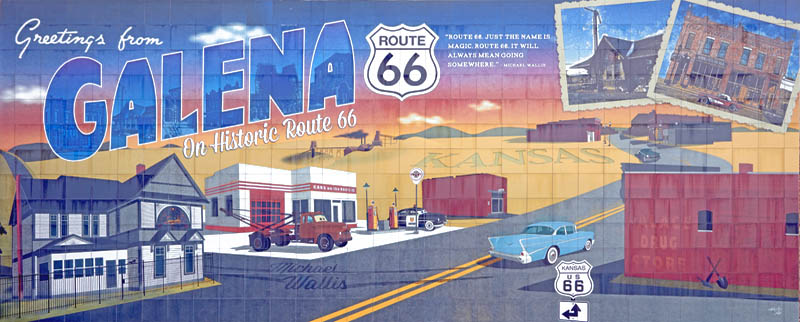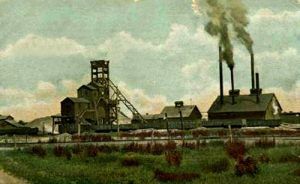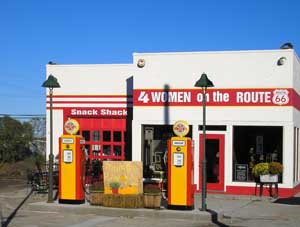The small town of Galena is in the rocky hills and gravel-filled valleys of southeast Kansas. It was born of rugged characters when lead was discovered in 1877. Before this time, the land was sparsely settled by hunters and farmers who earned a meager living from the rocky and sterile soil.
The Indians knew of the presence of lead in the area long before the white settlers began to populate it. Large lumps of almost pure lead were often found on or near the surface, melted, and made into bullets at the campfires.
In the spring of 1877, a couple of young white men found several heavy stones that contained high amounts of lead. The landowner, a German farmer named Egidius Moll, wasted no time making negotiations with the nearby Joplin, Missouri Mining Companies. Before long, richer deposits of ore were discovered, and by June 1, 1877, two rival companies were in the field bidding against each other for the lease and sale of mining lots. The two rival mining companies also formed their own town sites – Empire City, north of Short Creek, and Galena, south of the creek, named for the abundant bluish-grey lead to the south.
Galena was immediately laid out, and the excitement caused by the lead discovery was so great that no sooner was a lot staked off than a purchaser was ready with the money in hand to buy it. The influx of people was extremely rapid, so in about two months, Galena had a population of nearly 3,000 people. Business houses were hastily established, miners’ shanties were built by the dozens, and the townsite was dug up with mining excavations everywhere.
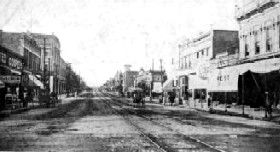
Galena Kansas Vintage.
A joint-stock company purchased a tract of 80 acres of railroad land adjoining the site called the South Side Town & Mining Company, which also became a part of the townsite.
Galena was incorporated as a city in May 1877, less than two months from when it was laid out. A post office was opened that same month, and the Galena Miner newspaper was established.
More wagons, tents, and hastily constructed buildings sprang up in the new boomtown, which, within months, supported a population of almost 10,000.
For a time, Galena and Empire City had a heated rivalry. Each kept pace with the other and sought to excel in the race.
The rivalry between the two mining companies carried forward into building the two towns, bound together by the rich veins of lead. Because Empire City was nearer the field of operations for the mining activities, most new settlers first camped upon that townsite. However, the natural advantage was with Galena since nearly the whole, and by far the richest, of the lead field lay beneath and near the town. No sooner was this fact discovered than Galena began to take the lead of Empire City. This change soon began to seriously hinder the Empire camp, which strove arduously to turn the tide and save themselves from being entirely absorbed.
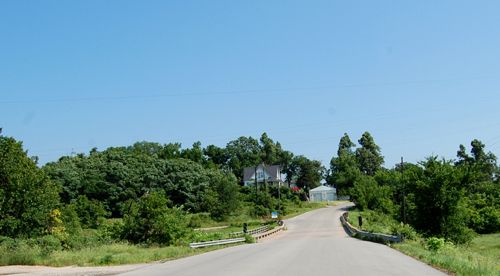
“Red Hot Street,” by Kathy Alexander, looks north from Galena to Empire City.
More friction naturally occurred with two cities striving to settle within their limits and the thousands rushing to the camp. The prospect of keeping order in the two mining camps was not a very promising one. Columbus Street in Empire and “Red Hot” and Main Streets in Galena were the first to build up with business houses of log and frame boxes, hastily thrown together for temporary use.
The quarrel assumed a serious aspect when Empire City decided to stop its population from moving over to the Galena side. On the night of July 25, 1877, the city council of Empire City passed a resolution ordering a stockade eight feet high and one-half mile in length to be built along the south side of their city. If the plan were carried out, it would virtually stop all communication between the two cities and hinder public travel. The stockade was to enclose the south end of Columbus Street and the bridge over Short Creek.
As the stockade began to be built, it created such an uproar that the workmen were given police protection while building the wall. Galena residents protested in vain, petitioning the city, which, in turn, appealed to the U.S. Government to prevent the closing of a public highway to the U.S. mail.
However, as the gap was being closed and the federal government’s action was too slow, the Galena Mayor, acting under the city council’s authority, organized a posse of 50 citizens to prevent closing the gap. On August 15, 1877, at 4:00 a.m., the posse attacked, tore down, and burned the more significant portion of the wall. Not anticipating the surprise attack, Empire City was unprepared, resulting in only a few shots and minimal bloodshed.
For several years, the two towns vied for dominance, with constant feuds between them and their residents. The war became so bad that the main connecting link between the two cities became known as “Red Hot Street.” When feuding became so intense, doctors and undertakers began working nights and sleeping during the days.
This feud, coupled with the countless miners, transients, and outlaws hiding within its midst, provided a hotbed for violence. In this section of the town were innumerable saloons and gambling halls that catered to murderers, outlaws, and gamblers. Many hardworking miners were lured inside to lose their hard-earned gold at the gaming tables and other questionable pastimes during this time. Some were never seen again.
During the early mining days, the population shifted and flourished along with the fortunes of the mining operations. Many enterprising entrepreneurs became wealthy during the early days of Galena, building fine homes and buildings. Others who did not find wealth in Galena soon pursued other endeavors.
In the fall of 1877, a building was constructed to serve several church denominations, including the Presbyterian, Episcopalian, and Methodist congregations.
In the winter of 1877-78, the first school was taught in a building built for a storeroom.
In the fall of 1878, H. Webb established a paper called the Short Creek Banner, which was sold the following year; the name was changed to The Messenger and moved to Columbus.
In 1879, the Kansas City, Fort Scott & Gulf Railroad extended its line to Galena, and before long, the St. Louis and San Francisco Railroad followed suit, extending its line from Joplin, Missouri. Deeper mining operations began in earnest, and the town soon saw all manner of passengers, freight, and lead being shipped through the area. The same year, the Presbyterians built their church, a one-story frame building.
A school building was also built in 1879, comprised of a large two-story frame structure containing four rooms. The school district also purchased four lots for the schoolhouse site, which were later found to contain rich lead deposits. A second school building was erected in 1880, a two-story frame containing two rooms. The land on which the previous school sat was leased for mining purposes, from which the school district profited handsomely. The Episcopalians erected their one-story church building the same year.
The Short Creek Republican newspaper was established on September 16, 1880. The name would later be changed to the Galena Republican. It survived until 1900. Another newspaper, the Galena Times, was founded in 1890 but suspended in 1899.
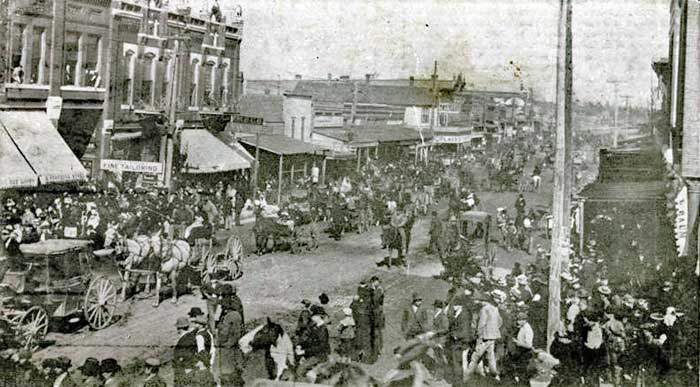
Galena, Kansas 1898.
By the late 1890s, Galena had 265 producing mines, two banks, 36 grocers, and more than four dozen other retail stores.
Galena continued to thrive, and by 1904, over 30 mining companies were situated in or near the town.
Finally, the dispute between Galena and Empire City entered the courts. After a long period of litigation, a truce was declared between the two cities, which finally began to work together to build one of the world’s best mining camps.
When Empire City became a suburb of Galena on July 9, 1907, the surrender of her rights as an incorporated city to Galena was made amid great rejoicing. Citizens of both settlements took pieces of the old stockade as souvenirs. Empire City was annexed into Galena as its Fifth Ward in 1910.
By that time, Galena boasted three banks, three newspapers, and an opera house. Though its primary lead and zinc mining and smelting remained their principal industries, there were also foundries, stamping works, grain elevators, novelty works, and a broom factory. The population in 1910 was 6,096.
When Route 66 came through Kansas in 1926, Galena, like other small towns along the Mother Road, responded with services to the many travelers, bringing additional prosperity to the thriving town.
However, just a few years later, terrible labor strikes between the miners and the mining companies would result in hundreds of unemployed miners and bloodshed along Route 66. In 1935, the Mine, Mills, and Smelter Workers’ International Union members went on strike in the Tri-State Mining District. The mining companies were unimpressed and quickly replaced the strikers with non-union workers organized into a company union, commonly called the Blue Card Union.
As a result, a mob of angry, unemployed miners blocked Route 66 and sprayed bullets and rocks onto any passing vehicles that failed to follow their commands. They were particularly interested in any vehicles transporting the scabs belonging to the Blue Card Union. Police officers were forced to detour the Route 66 traffic, and then Governor Alf Landon declared martial law in Galena and dispatched National Guard troops to quell the violence.
However, the unrest would continue for the next few years before exploding into violence again in April 1937 when the Committee for Industrial Organization (CIO) undertook to aid the unemployed workers of the Mine, Mill, and Smelter Workers’ Union. While the unemployed miners were distributing leaflets for the CIO at a smelter in Joplin, Missouri, they were seized by Blue Card unionists and severely beaten on April 10, 1937. The next day, about 5,000 members of the Blue Card Union met at Picher, Oklahoma, armed with clubs and pick handles to disperse a meeting of CIO organizers and wrecked the local Union Hall. They then traveled to Treece, Kansas, where they demolished another Union Hall before continuing to Galena.
However, unemployed union members in Galena had been forewarned and barricaded their meeting hall. When the Blue Card mob arrived, brandishing clubs, gunfire broke out, and nine men were shot, one fatally. Ultimately, the hall was wrecked, and the union records were stolen. Twenty-five members of the Blue Card Union and ten members of the CIO were later arrested.
Though mining continued until the 1970s, it was never the same. The mines were eventually exhausted, and the population dwindled to less than a tenth of its former glory.
By the time the last lead and zinc mines closed in Cherokee County, nearly 2.9 million tons of zinc and 700,000 tons of lead had been produced.
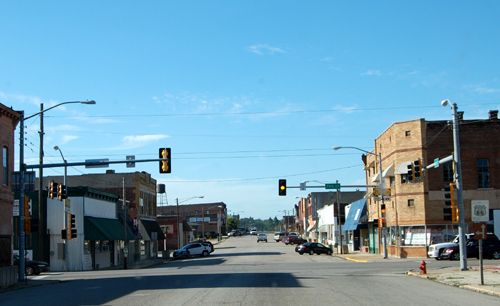
Galena, Kansas Today.
Up until just a few years ago, the Galena area and the Tri-State Mining District, which encompasses approximately 2,500 square miles in southeastern Kansas, southwestern Missouri, and northeastern Oklahoma, was dotted with chat piles and mine tailings. These, however, led to environmental problems when the lead, zinc, and other minerals began to leech into the shallow groundwater. Contaminating wells and nearby streams and rivers, the Environmental Protection Agency began to clean up the area in 1983. Completed today, most old sites have been returned to their natural state. Few mining remnants, besides buildings, foundations, and scattered mining equipment, can be seen.
After the clean-up, the area remained dangerous, as old mining shafts and tunnels still ran beneath. In 2006, a mine collapse caused two historic buildings in Galena to cave in. Building stabilization is an ongoing effort today.
Galena is home to about 3,000 people today and provides peeks at several historic buildings, including vintage examples of the Mother Road and architecture from this historic city’s booming cattle and mining days.
A must-stop along Route 66 is Cars on the Route (originally called 4 Women on the Route), housed in an old KanOtex Service Station. Right beside the station is “Tow Tater,” a 1951 International boom truck that was the inspiration for “Tow Mater” in the movie Cars, plus vehicles that resemble Doc the Hornet Hudson, Red (the fire truck), and a Buick as the Sheriff of Radiator Springs.
Make sure to stop at the Historical and Mining Museum to learn all about Galena’s rich history.
Galena is four miles north of the Oklahoma border and immediately west of the Missouri state line.
If you’re traveling Route 66, keep your eyes open because the next small town on the Kansas Mother Road is just some three miles down the road. Enjoy the ride as you head to Riverton, Kansas.

